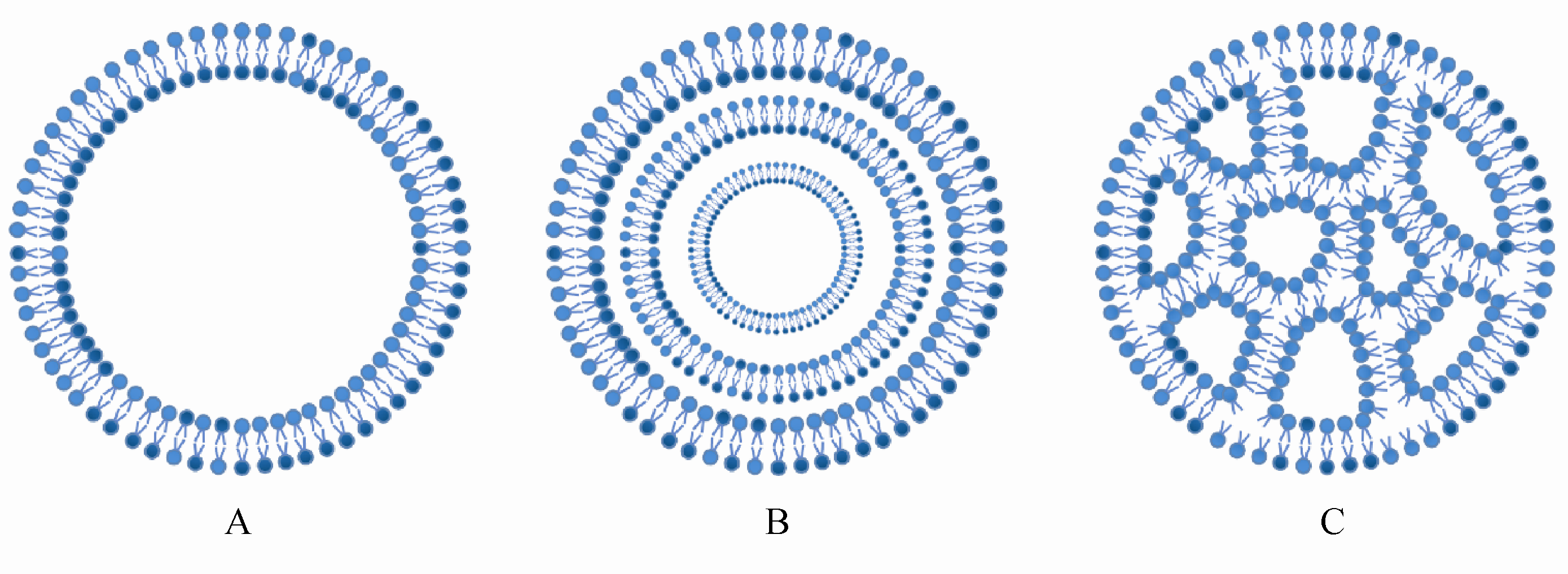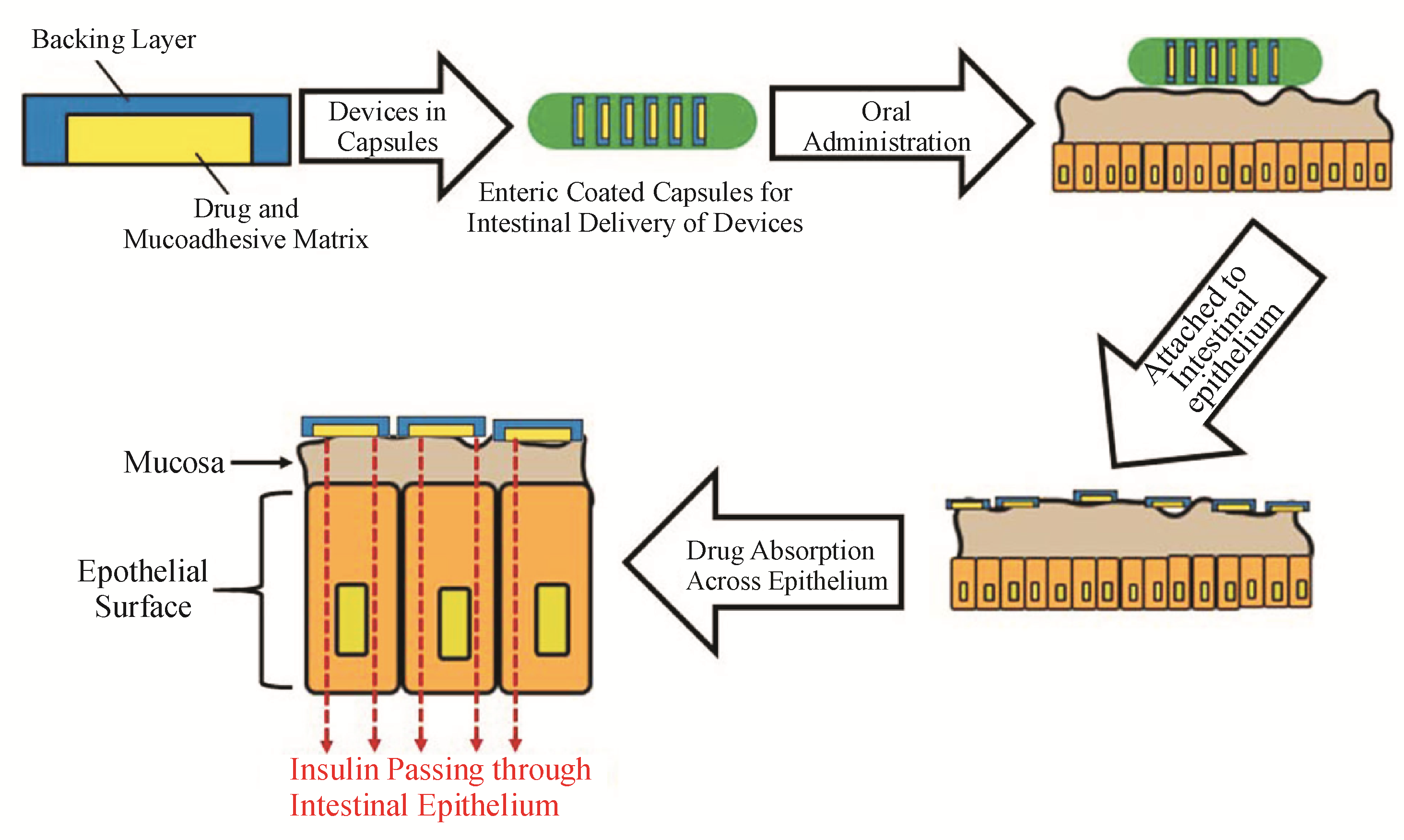摘要
蛋白及多肽类药物近年来越来越多地应用到疾病的预防、诊断和治疗之中,然而,蛋白及多肽类药物通常需要注射给药且缺乏长效剂型,给需要长期用药的慢性病患者带来困扰。本文综述了通过制剂学手段对蛋白及多肽类药物进行长效化改造的策略,包括缓释注射剂、植入剂、口服制剂以及经皮给药系统,并总结其缓释机制、研究进展和优缺点,以期为此类药物的剂型改良提供研究思路及理论参考。
蛋白及多肽类药物通常具有特定的三维结构和作用位点,从而能够在体内发挥特异性的治疗作用,与传统药物相比有更好的临床有效性和安全性。然而,此类药物大多存在稳定性差、给药剂量小、体内半衰期短、生物利用度低等问题,尤其是治疗慢性疾病的蛋白及多肽类药物往往需要长期、频繁注射,不仅顺应性低,还可能导致其他不良反应的产

Figure 1 Graphical tablet of major strategies for preparation of long-acting formulations containing proteins and peptides
微球一般通过皮下或肌肉注射给药,并随着载体的缓慢溶蚀而持续释放药物。艾塞那肽是由美国FDA批准的第1个胰高血糖素样肽-1(GLP-1)受体激动剂类多肽药物,用于改善2型糖尿病患者的血糖控制,其普通剂型(商品名Byett
随着PLGA的广泛应用,研究人员已可以采用多种手段调控PLGA微球释放速率。首先,可在微球中加入致孔剂,主要包括无机盐类(如NaHCO3、NH4HCO
然而,PLGA微球常常会在给药初期产生显著的突释现象,这可能是由于微球表面存在吸附药物或药物在微球中分布不
除PLGA,其他常见的缓释微球用材料还包括聚乳酸 (PLA)、壳聚糖(chitosan, CS)等。例如,采用PLA制备的Lupron Depor
在蛋白及多肽类药物缓释脂质体的开发中,采用DepoFoa

Figure 2 Structures of different kinds of liposomes
A: Unilamellar vesicle (ULV); B: Multilamellar vesicle (MLV); C: Multivesicular liposome (MVL) or DepoFoa
植入剂临床使用时需要通过手术将其埋入组织或非手术形式塞入腔道内,相比于微粒形式的储库往往具有更长的释放周期。已上市的蛋白及多肽药物的植入剂包括:组胺瑞林长效植入剂(商品名Vanta
在植入剂的研究中,如何提高载药量、减少药物突释、延长药物作用时间是研究人员关注的重点。多数植入剂具有先快后慢的释药特点,导致植入早期存在发生不良反应的风险,而末期难以维持有效治疗剂量。针对这一问题,有研究人员通过氢键作用交替涂覆PEG化的鲑鱼降钙素和单宁酸形成植入膜,这种夹心膜结构能够在多种条件下实现零级释
植入剂与人工智能的结合可实现更加精准的药物控释能力。为研究不同药物对动物行为能力的影响,研究人员通过电路设计和材料筛选开发了四通道、光流控、可编程的脑部植入型探针,可在不限制动物行为的情况下,通过遥控精确控制不同药物的脑部泵
此类制剂可通过液体或半固体形式注射,并在注射处发生相转变形成固态植入
此类制剂注射前通常应为具有良好通针性的前体溶液(即将蛋白/多肽、水不溶型载体材料和处方中的其他辅料溶解于可与水混溶的有机溶剂中),原位注射后,有机溶剂扩散和/或被水替代,导致载体材料聚集/固化将蛋白或多肽包裹其
本课题组以乙醇为溶剂、二油酸甘油酯和磷脂为基质制备了可相变脂质凝胶,实现抗PD-L1抗体(αPD-L1)和近红外光热剂IR820的肿瘤原位共递
此类制剂的开发基于聚合物溶解度的温敏特性,即一定浓度的聚合物达到特定温度后可发生“溶胶-凝胶(sol-gel)”相转变,而相变温度受聚合物HLB值和混合自由能影

Figure 3 Typical mechanism of thermo-sensitive gelation
泊洛沙姆(poloxamer)是最经典的温敏聚合物,其具有聚氧乙烯-聚氧丙烯-聚氧乙烯(PEO-PPO-PEO)三嵌段结构。然而,泊洛沙姆亲水性强且机械强度较低,在给药初期易发生突释,并且生物相容性较差,易导致蓄积毒
此外,PBLA-PEG-PBL
蛋白及多肽类药物的口服吸收需要克服低pH环境、酶水解、肠黏膜屏障、首过效应等诸多不利因素,因此,开发蛋白及多肽类药物的口服剂型(尤其是长效缓释类剂型)存在较大困难,但长期以来科研人员仍持续努力,口服长效制剂一直是热点研究方向。
口服制剂实现长效缓释作用,需要延长其在消化道中的停留时间并避免药物被降解。受到皮肤贴剂的启发,研究人员开发了一类肠黏附药物储库,其作用机制见

Figure 4 Schematic representation of mechanism of adhesion, drug release and absorption across intestinal epithelium from mucoadhesive device
口服小粒径、正电荷且具有粗糙表面的微粒更易于在胃肠道滞留和被肠道吸
蛋白和多肽类药物往往具有较高的相对分子质量,难以实现有效的皮肤渗透,而微针的出现有效解决了这一问题。微针贴剂系由微米级的小针组成阵列,并附着在背衬材料上制成的一种透皮制剂。微针的长度可以刺穿角质层,却不会达到神经末梢,因此不会引起疼痛。微针贴剂已应用于多种蛋白及多肽类药物的递送,包括干扰素
为提高微针在皮肤上固定的稳定性,研究人员开发了可自膨胀微针。Seong
此外,为使微针在体内滞留时间更长,研究人员开发了一类前端可脱落的生物可降解微针。Chen
通过缓释注射剂、植入剂、口服制剂、经皮给药等制剂手段可以实现蛋白和多肽药物的长效化,而不同技术手段具有不同的优缺点(
经过几十年的发展,目前此类制剂研究仍主要集中于植入剂和注射用微球的开发,制剂开发的难点仍是筛选合适载体、提高药物稳定性、减少突释和实现药物平稳释放。而未来,随着更多新材料、制剂新技术和微型芯片技术在生物医药领域的应用,响应体内生理指标变化的智能释放药物将成为下一代缓控释制剂的主要研究方向,为通过制剂手段实现蛋白及多肽药物的长效化提供更多可选方案。总之,蛋白及多肽类药物的长效递送具有重要临床意义和广阔的市场前景。
参考文献
Vaishya R, Khurana V, Patel S, et al. Long-term delivery of protein therapeutics[J]. Expert Opin Drug Deliv, 2015, 12(3):415-440. [百度学术]
Vaishya RD, Khurana V, Patel S, et al. Controlled ocular drug delivery with nanomicelles[J]. Wiley Interdiscip Rev Nanomed Nanobiotechnol, 2014, 6(5):422-437. [百度学术]
Jia H, Guo Y, Song X, et al. Elimination of N-glycosylation by site mutation further prolongs the half-life of IFN-alpha/Fc fusion proteins expressed in Pichia pastoris[J]. Microb Cell Fact, 2016, 15(1):209. [百度学术]
Czajkowsky DM, Hu J, Shao Z, et al. Fc-fusion proteins: new developments and future perspectives[J]. EMBO Mol Med, 2012, 4(10):1015-1028. [百度学术]
Kim D, Jeon H, Ahn S, et al. An approach for half-life extension and activity preservation of an anti-diabetic peptide drug based on genetic fusion with an albumin-binding aptide[J]. J Control Release, 2017, 256:114-120. [百度学术]
Li CY, Huang WL, Qian H. Advances in the research of long-acting strategy of insulin and GLP-1 analogs[J]. J China Pharm Univ(中国药科大学学报), 2018, 49(6):660-670. [百度学术]
Deyle K, Kong XD, Heinis C. Phage selection of cyclic peptides for application in research and drug development[J]. Acc Chem Res, 2017, 50(8):1866-1874. [百度学术]
Kim D, MacConell L, Zhuang D, et al. Effects of once-weekly dosing of a long-acting release formulation of exenatide on glucose control and body weight in subjects with type 2 diabetes[J]. Diabetes Care, 2007, 30(6):1487-1493. [百度学术]
Oh YJ, Lee JW, Seo JY, et al. Preparation of budesonide-loaded porous PLGA microparticles and their therapeutic efficacy in a murine asthma model[J]. J Control Release, 2011, 150(1):56-62. [百度学术]
Zhang Y, Wischke C, Mittal S, et al. Design of controlled release PLGA microspheres for hydrophobic fenretinide[J]. Mol Pharm, 2016, 13(8):2622-2630. [百度学术]
Rosa GD, Iommelli R, La Rotonda MI, et al. Influence of the co-encapsulation of different non-ionic surfactants on the properties of PLGA insulin-loaded microspheres[J]. J Control Release, 2000, 69(2):283-295. [百度学术]
Bae SE, Son JS, Park K, et al. Fabrication of covered porous PLGA microspheres using hydrogen peroxide for controlled drug delivery and regenerative medicine[J]. J Control Release, 2009, 133(1):37-43. [百度学术]
Casalini T, Rossi F, Lazzari S, et al. Mathematical modeling of PLGA microparticles: from polymer degradation to drug release[J]. Mol Pharm, 2014, 11(11):4036-4048. [百度学术]
Jain RA. The manufacturing techniques of various drug loaded biodegradable poly(lactide-co-glycolide) (PLGA) devices[J]. Biomaterials, 2000, 21(23):2475-2490. [百度学术]
Díaz E, Puerto I, Ribeiro S, et al. The influence of copolymer composition on PLGA/nHA Scaffolds' cytotoxicity and in vitro degradation[J]. Nanomaterials (Basel), 2017, 7(7): 173. [百度学术]
Yang S, Yuan W, Jin T. Formulating protein therapeutics into particulate forms[J]. Expert Opin Drug Deliv, 2009, 6(10):1123-1133. [百度学术]
Wu JZ, Williams GR, Li HY, et al. Insulin-loaded PLGA microspheres for glucose-responsive release[J]. Drug Deliv, 2017, 24(1):1513-1525. [百度学术]
Jain A, Kunduru KR, Basu A, et al. Injectable formulations of poly(lactic acid) and its copolymers in clinical use[J]. Adv Drug Deliv Rev, 2016, 107:213-227. [百度学术]
Guo J, Sun X, Yin H, et al. Chitosan microsphere used as an effective system to deliver a linked antigenic peptides vaccine protect mice against acute and chronic toxoplasmosis[J]. Front Cell Infect Microbiol, 2018, 8:163. [百度学术]
Mantripragada S. A lipid based depot (DepoFoa
Bulbake U, Doppalapudi S, Kommineni N, et al. Liposomal formulations in clinical use: an updated review[J]. Pharmaceutics, 2017, 9(2): 12. [百度学术]
Lewis KA, Goldyn AK, West KW, et al. A single histrelin implant is effective for 2 years for treatment of central precocious puberty[J]. J Pediatr, 2013, 163(4):1214-1216. [百度学术]
Moore HC, Unger JM, Phillips KA, et al. Goserelin for ovarian protection during breast-cancer adjuvant chemotherapy[J]. N Engl J Med, 2015, 372(10):923-932. [百度学术]
Zhao YN, Xu X, Wen N, et al. A drug carrier for sustained Zero-order release of peptide therapeutics[J]. Sci Rep, 2017, 7(1):5524. [百度学术]
Jeong JW, McCall JG, Shin G, et al. Wireless optofluidic systems for programmable in vivo Pharmacology and optogenetics[J]. Cell, 2015, 162(3):662-674. [百度学术]
Farra R, Sheppard NF, McCabe L, et al. First-in-human testing of a wirelessly controlled drug delivery microchip[J]. Sci Transl Med, 2012, 4(122):122ra121. [百度学术]
Parent M, Clarot I, Gibot S, et al. One-week in vivo sustained release of a peptide formulated into in situ forming implants[J]. Int J Pharm, 2017, 521(1/2):357-360. [百度学术]
Brodbeck KJ, DesNoyer JR, McHugh AJ. Phase inversion dynamics of PLGA solutions related to drug delivery. Part II. The role of solution thermodynamics and bath-side mass transfer[J]. J Control Release, 1999, 62(3):333-344. [百度学术]
Huang LP, Li YN, Du YA, et al. Mild photothermal therapy potentiates anti-PD-L1 treatment for immunologically cold tumors via an all-in-one and all-in-control strategy[J]. Nat Commun, 2019, 10(1):4871. [百度学术]
Ruel-Gariepy E, Leroux JC. In situ-forming hydrogels—review of temperature-sensitive systems[J]. Eur J Pharm Biopharm, 2004, 58(2):409-426. [百度学术]
Agarwal P, Rupenthal ID. Injectable implants for the sustained release of protein and peptide drugs[J]. Drug Discov Today, 2013, 18(7):337-349. [百度学术]
Singh NK, Lee DS. In situ gelling pH- and temperature-sensitive biodegradable block copolymer hydrogels for drug delivery[J]. J Control Release, 2014, 193:214-227. [百度学术]
Liu Y, Chen X, Li S, et al. Calcitonin-loaded thermosensitive hydrogel for long-term antiosteopenia therapy[J]. ACS Appl Mater Interfaces, 2017, 9(28):23428-23440. [百度学术]
Xu YR, Shen Y, Xiong YR, et al. Synthesis, characterization, biodegradability and biocompatibility of a temperature-sensitive PBLA-PEG-PBLA hydrogel as protein delivery system with low critical gelation concentration[J]. Drug Dev Ind Pharm, 2014, 40(9):1264-1275. [百度学术]
Feng Z, Zhao J, Li Y, et al. Temperature-responsive in situ nanoparticle hydrogels based on hydrophilic pendant cyclic ether modified PEG-PCL-PEG[J]. Biomater Sci, 2016, 4(10):1493-1502. [百度学术]
Lai MC, Chang KC, Hsu SC, et al. In situ gelation of PEG-PLGA-PEG hydrogels containing high loading of hydroxyapatite: in vitro and in vivo characteristics[J]. Biomed Mater, 2014, 9(1):015011. [百度学术]
Bobbala S, Tamboli V, McDowell A, et al. Novel injectable pentablock copolymer based thermoresponsive hydrogels for sustained release vaccines[J]. AAPS J, 2016, 18(1):261-269. [百度学术]
Wang C, Wang J, Zhang X, et al. In situ formed reactive oxygen species-responsive scaffold with gemcitabine and checkpoint inhibitor for combination therapy[J]. Sci Transl Med, 2018, 10(429):eaan3682. [百度学术]
Zhao Y, Cui Z, Liu B, et al. An injectable strong hydrogel for bone reconstruction[J]. Adv Healthc Mater, 2019, 8(17):e1900709. [百度学术]
Nguyen NT, Nguyen LV, Tran NM, et al. The effect of oxidation degree and volume ratio of components on properties and applications of in situ cross-linking hydrogels based on chitosan and hyaluronic acid[J]. Mater Sci Eng C Mater Biol Appl, 2019, 103:109670. [百度学术]
Criado-Gonzalez M, Corbella L, Senger B, et al. Photoresponsive nanometer-scale iron alginate hydrogels: a study of gel-sol transition using quartz crystal microbalance[J]. Langmuir, 2019, 35(35):11397-11405. [百度学术]
Gupta V, Hwang BH, Doshi N, et al. Delivery of exenatide and insulin using mucoadhesive intestinal devices[J]. Ann Biomed Eng, 2016, 44(6):1993-2007. [百度学术]
Gupta V, Hwang BH, Lee JH, et al. Mucoadhesive intestinal devices for oral delivery of salmon calcitonin[J]. J Control Release, 2013, 172(3):753-762. [百度学术]
Castro PM, Fonte P, Sousa F, et al. Oral films as breakthrough tools for oral delivery of proteins/peptides[J]. J Control Release, 2015, 211:63-73. [百度学术]
Salvioni L, Fiandra L, Del CMD, et al. Oral delivery of insulin via polyethylene imine-based nanoparticles for colonic release allows glycemic control in diabetic rats[J]. Pharmacol Res, 2016, 110:122-130. [百度学术]
Zhao XH, Shan C, Zu YG, et al. Preparation, characterization, and evaluation in vivo of Ins-SiO2-HP55 (insulin-loaded silica coating HP55) for oral delivery of insulin[J]. Int J Pharm, 2013, 454(1):278-284. [百度学术]
Chuang EY, Lin KJ, Lin PY, et al. Self-assembling bubble carriers for oral protein delivery[J]. Biomaterials, 2015, 64:115-124. [百度学术]
Leonaviciute G, Bernkop-Schnurch A. Self-emulsifying drug delivery systems in oral (poly)peptide drug delivery[J]. Expert Opin Drug Deliv, 2015, 12(11):1703-1716. [百度学术]
Kusamori K, Katsumi H, Sakai R, et al. Development of a drug-coated microneedle array and its application for transdermal delivery of interferon alpha[J]. Biofabrication, 2016, 8(1):015006. [百度学术]
Lau S, Fei J, Liu H, et al. Multilayered pyramidal dissolving microneedle patches with flexible pedestals for improving effective drug delivery[J]. J Control Release, 2017, 265:113-119. [百度学术]
van der Maaden K, Heuts J, Camps M, et al. Hollow microneedle-mediated micro-injections of a liposomal HPV E743-63 synthetic long peptide vaccine for efficient induction of cytotoxic and T-helper responses[J]. J Control Release, 2018, 269:347-354. [百度学术]
Qiu YQ, Qin GJ, Zhang SH, et al. Novel lyophilized hydrogel patches for convenient and effective administration of microneedle-mediated insulin delivery[J]. Int J Pharm, 2012, 437(1):51-56. [百度学术]
Seong KY, Seo MS, Hwang DY, et al. A self-adherent, bullet-shaped microneedle patch for controlled transdermal delivery of insulin[J]. J Control Release, 2017, 265:48-56. [百度学术]
Chen MC, Huang SF, Lai KY, et al. Fully embeddable chitosan microneedles as a sustained release depot for intradermal vaccination[J]. Biomaterials, 2013, 34(12):3077-3086. [百度学术]
Kim MY, Jung BK, Park JH. Hydrogel swelling as a trigger to release biodegradable polymer microneedles in skin[J]. Biomaterials, 2012, 33(2):668-678. [百度学术]
Ganesan P, Choi DK. Current application of phytocompound-based nanocosmeceuticals for beauty and skin therapy[J]. Int J Nanomedicine, 2016, 11:1987-2007. [百度学术]
Wu PS, Li YS, Kuo YC, et al. Preparation and evaluation of novel transfersomes combined with the natural antioxidant resveratrol[J]. Molecules, 2019, 24(3):600. [百度学术]
Carter P, Narasimhan B, Wang Q. Biocompatible nanoparticles and vesicular systems in transdermal drug delivery for various skin diseases[J]. Int J Pharm, 2019, 555:49-62. [百度学术]
Desai P, Patlolla RR, Singh M. Interaction of nanoparticles and cell-penetrating peptides with skin for transdermal drug delivery[J]. Mol Membr Biol, 2010, 27(7):247-259. [百度学术]